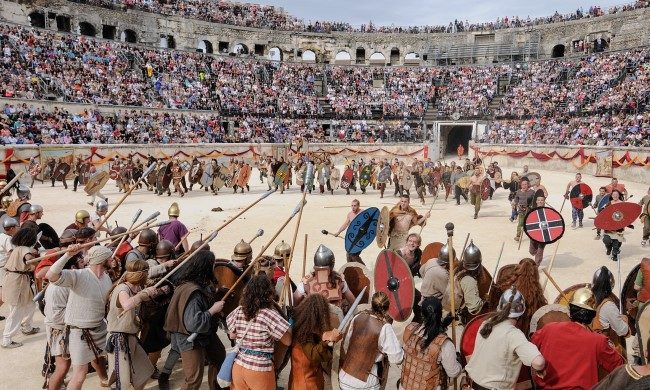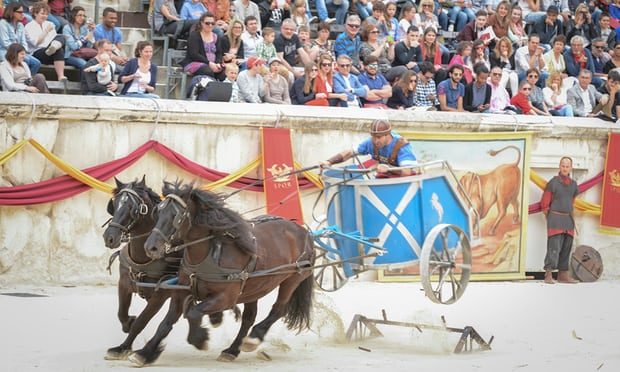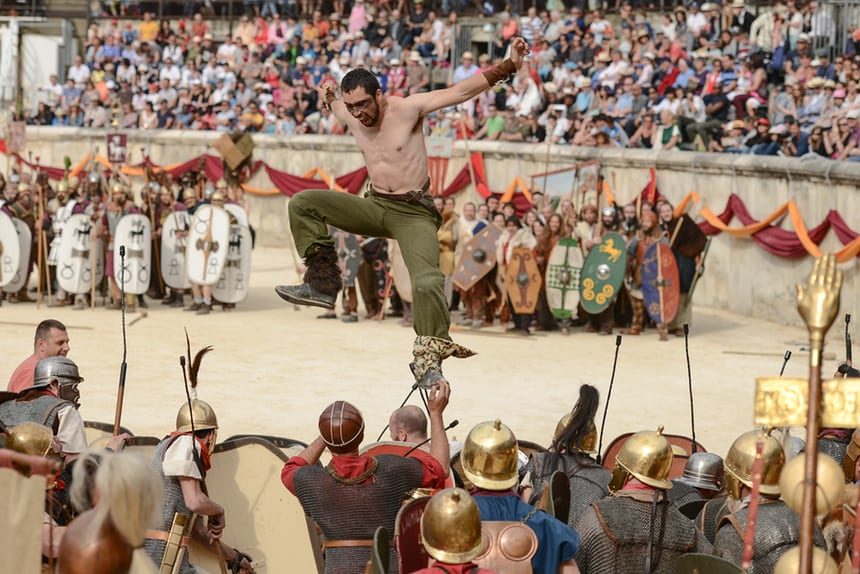
At one of Europe's biggest re-enactment spectaculars, this year's show is Spartacus-themed. So, take a seat in the mighty arena alongside 12,000 spectators (togas optional)
The first gladiator is down, flailing his gladius towards the emperor before being pummelled by a giant hammer (thankfully, into a furrow of sand left by one of the racing chariots). Two "slaves" rush on and drag his body off towards the spoliarium. Suddenly, everyone is up out of their seats: the retiarius (net man) has dropped his trident and the mirmillones (fish men) are closing in.
Nîmes' Les Grands Jeux Romains (Great Roman Games) is one of the biggest re-enactment spectaculars in Europe. Sitting among 12,000 handkerchief-waving spectators in the city's first-century Roman amphitheatre last year, I realised it makes for a mesmerising and charmingly-brutal event. Having already featured Hannibal (2015), Cleopatra (2016) and, last year, Boudicca, this year's games, which take place from 28-30 April, is devoted to Spartacus.
"The first Great Roman Games was held in Nîmes in 2010 with little publicity," says Valérie Espin, in charge of the games' organisation company, Culturespaces. "The idea was just to have some chariots parading around the arena and people dressed up as Romans. But it has captured the public's imagination and now there is a cast of 500 performing in front of 32,000 spectators over three days."
In the corner of Espin's office is a giant scutum (curved Roman shield) and on top of her filing cabinet, a pair of gladiator helmets. "Participants take it very seriously," she says. "Most of the re-enactors meet weekly, dress up as Romans and spend the weekend on camps, training for battles, preparing Roman food, testing equipment and living as Romans."
This year there are 28 different Roman associations taking part: 11 from France, 16 from Italy, one from Croatia and, for the first time, a group from Britain, Legio Secunda Augusta.
"Seven of us are going to Nîmes from our gladiator group based in Portsmouth," says dental nurse and weekend gladiatrix, Alisa Vanlint. "All the names we use are authentic; the Second Augustus Legion was based in Britain for a while."
It's also the first time female gladiators will fight at the games. "I am Achillia and will be fighting Amazonia - the names come from a marble relief in the British Museum."
Vanlint teaches stage combat and also re-enacts medieval and "1805" battles but her favourite is Roman. "I love sharing an amazing piece of history." She will appear in the oval arena straight after the horse chases and then as a slave in Spartacus's army in the second part of the show. Other members of Legio Secunda Augusta are soldiers and civilians.
"The helmets are heavy but once you're fighting, the adrenalin kicks in and the longer you wear it the easier it becomes. I don't notice it after a while, it's the same with cuts and bruises," says Vanlint.
Outside the arena, the city's street's will also be hectic with Roman revelry. There's a Roman market selling asses' milk cosmetics, oil, grapejuice and honey followed by a night-time parade with flaming torches. A Roman galley is on the esplanade and local restaurants will serve Roman-style food, while children solve clues in a treasure-hunt-enigma game.
Restoration of the arena will continue for another 12 years. "Repairs of the terraces have given us another 130 seats this year," says Espin. "Many of the local buildings contain stones looted from the amphitheatre and replacements come from the same Nîmes quarries as they did in Roman times.
Besides the arcaded amphitheatre, Nîmes also has the Maison Carrée temple and the Tour Magne. All three can be visited on a combined ticket (€13 adult, €11 child, family ticket €40). Nîmes' will also see its spectacular new Musée de la Romanité open on 2 June, with 3,500 square metres of multimedia exhibition space dedicated to Roman mosaics, sculptures and everyday objects. Its first exhibition, Gladiators: Heroes of the Colosseum, runs until 24 September 2018.
There are also the ruins of the Temple of Diana, as well as two Roman city gates and the Castellum that collected water carried in from Uzès across the Pont du Gard viaduct.





Reader Comments
to our Newsletter